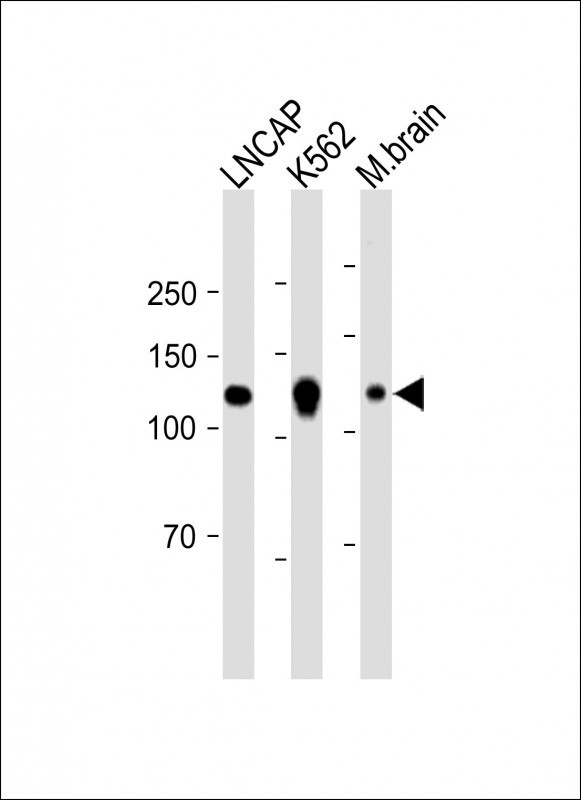SCAP Antibody (N-term)
Purified Mouse Monoclonal Antibody (Mab)
- 产品详情
- 实验流程
- 背景知识
Application
| WB, E |
|---|---|
| Primary Accession | Q12770 |
| Reactivity | Human |
| Host | Mouse |
| Clonality | monoclonal |
| Isotype | IgG1,κ |
| Clone Names | 1992C245.37.16 |
| Calculated MW | 139729 Da |
| Gene ID | 22937 |
|---|---|
| Other Names | Sterol regulatory element-binding protein cleavage-activating protein, SCAP, SREBP cleavage-activating protein, SCAP, KIAA0199 |
| Target/Specificity | This SCAP antibody is generated from a mouse immunized with a KLH conjugated synthetic peptide between 49-83 amino acids from the N-terminal region of human SCAP. |
| Dilution | WB~~1:1000 E~~Use at an assay dependent concentration. |
| Format | Purified monoclonal antibody supplied in PBS with 0.09% (W/V) sodium azide. This antibody is purified through a protein G column, followed by dialysis against PBS. |
| Storage | Maintain refrigerated at 2-8°C for up to 2 weeks. For long term storage store at -20°C in small aliquots to prevent freeze-thaw cycles. |
| Precautions | SCAP Antibody (N-term) is for research use only and not for use in diagnostic or therapeutic procedures. |
| Name | SCAP {ECO:0000303|PubMed:10570913, ECO:0000312|HGNC:HGNC:30634} |
|---|---|
| Function | Escort protein required for cholesterol as well as lipid homeostasis (By similarity). Regulates export of the SCAP-SREBP complex from the endoplasmic reticulum to the Golgi upon low cholesterol, thereby regulating the processing of sterol regulatory element-binding proteins (SREBPs) SREBF1/SREBP1 and SREBF2/SREBP2 (PubMed:26311497). At high sterol concentrations, formation of a ternary complex with INSIG (INSIG1 or INSIG2) leads to mask the ER export signal in SCAP, promoting retention of the complex in the endoplasmic reticulum (By similarity). Low sterol concentrations trigger release of INSIG, a conformational change in the SSD domain of SCAP, unmasking of the ER export signal, promoting recruitment into COPII-coated vesicles and transport of the SCAP-SREBP to the Golgi: in the Golgi, SREBPs are then processed, releasing the transcription factor fragment of SREBPs from the membrane, its import into the nucleus and up-regulation of LDLR, INSIG1 and the mevalonate pathway (PubMed:26311497). Binds cholesterol via its SSD domain (By similarity). |
| Cellular Location | Endoplasmic reticulum membrane; Multi-pass membrane protein. Golgi apparatus membrane; Multi-pass membrane protein. Cytoplasmic vesicle, COPII-coated vesicle membrane {ECO:0000250|UniProtKB:P97260}; Multi-pass membrane protein. Note=Moves from the endoplasmic reticulum to the Golgi in the absence of sterols (PubMed:26311497). Requires the presence of SPRING1 for proper localization to endoplasmic reticulum (PubMed:32111832). {ECO:0000250|UniProtKB:P97260, ECO:0000269|PubMed:26311497, ECO:0000269|PubMed:32111832} |
For Research Use Only. Not For Use In Diagnostic Procedures.
Provided below are standard protocols that you may find useful for product applications.
BACKGROUND
Escort protein required for cholesterol as well as lipid homeostasis. Regulates export of the SCAP/SREBF complex from the ER upon low cholesterol. Formation of a ternary complex with INSIG at high sterol concentrations leads to masking of an ER-export signal in SCAP and retention of the complex in the ER. Low sterol concentrations trigger release of INSIG, a conformational change in the SSC domain of SCAP, unmasking of the ER export signal, recruitment into COPII-coated vesicles, transport to the Golgi complex, proteolytic cleavage of SREBF in the Golgi, release of the transcription factor fragment of SREBF from the membrane, its import into the nucleus and up-regulation of LDLR, INSIG1 and the mevalonate pathway (By similarity).
REFERENCES
Nakajima T.,et al.J. Hum. Genet. 44:402-407(1999).
Nagase T.,et al.DNA Res. 3:17-24(1996).
Nakajima D.,et al.DNA Res. 9:99-106(2002).
Ota T.,et al.Nat. Genet. 36:40-45(2004).
Otsuki T.,et al.DNA Res. 12:117-126(2005).
终于等到您。ABCEPTA(百远生物)抗体产品。
点击下方“我要评价 ”按钮提交您的反馈信息,您的反馈和评价是我们最宝贵的财富之一,
我们将在1-3个工作日内处理您的反馈信息。
如有疑问,联系:0512-88856768 tech-china@abcepta.com.























 癌症的基本特征包括细胞增殖、血管生成、迁移、凋亡逃避机制和细胞永生等。找到癌症发生过程中这些通路的关键标记物和对应的抗体用于检测至关重要。
癌症的基本特征包括细胞增殖、血管生成、迁移、凋亡逃避机制和细胞永生等。找到癌症发生过程中这些通路的关键标记物和对应的抗体用于检测至关重要。 为您推荐一个泛素化位点预测神器——泛素化分析工具,可以为您的蛋白的泛素化位点作出预测和评分。
为您推荐一个泛素化位点预测神器——泛素化分析工具,可以为您的蛋白的泛素化位点作出预测和评分。 细胞自噬受体图形绘图工具为你的蛋白的细胞受体结合位点作出预测和评分,识别结合到自噬通路中的蛋白是非常重要的,便于让我们理解自噬在正常生理、病理过程中的作用,如发育、细胞分化、神经退化性疾病、压力条件下、感染和癌症。
细胞自噬受体图形绘图工具为你的蛋白的细胞受体结合位点作出预测和评分,识别结合到自噬通路中的蛋白是非常重要的,便于让我们理解自噬在正常生理、病理过程中的作用,如发育、细胞分化、神经退化性疾病、压力条件下、感染和癌症。






